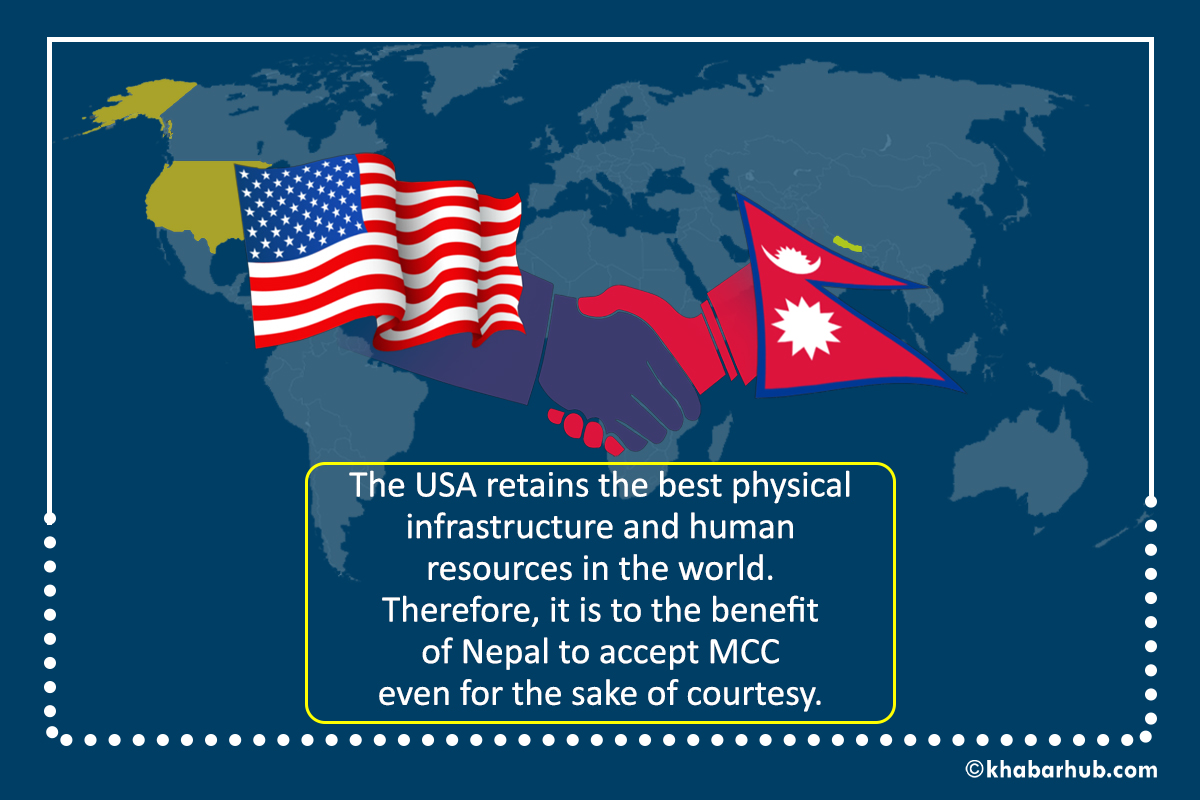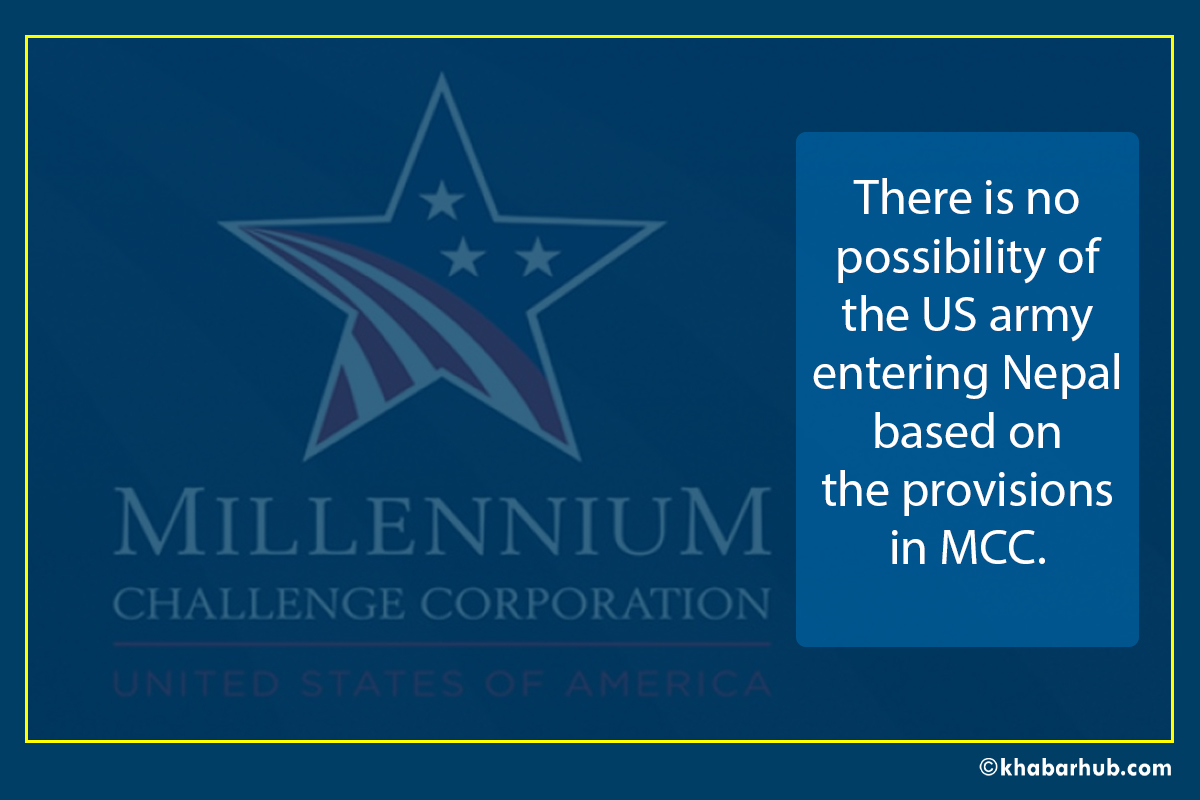Then Finance Minister of Nepal, Gyanendra Bahadur Karki, signed on the USD 500 million Millennium Challenge Compact (MCC) with the Acting MCC CEO, Jonathan Nash, on September 14, 2017.
Nearly three years down the line, the largest bilateral aid to Nepal has courted controversy in Nepal like never before.
There has been a lot of debate for and against MCC on social media. People have been debating every clause of MCC on social media and newspapers.
Debate on any issue is desirable since debate leads to ultimate truth as goes the Sanskrit saying “Bade Bade Jayete Tatwa Bodh.”
If the ongoing debate on MCC leads to the right conclusion it will ultimately benefit the country and people.
However, these debates should be based on facts. If influential opinion leaders carry on the debate by twisting facts that could have a big negative impact on society.
MCC has now been politicized and wrong facts are being disseminated. However, some of the arguments for and against MCC bear gravity.
Such issues need to be debated. However, there has also been the trend of twisting facts to serve vested interests and making arguments without studying the agreement minutely.
Whatever the reasons, false interpretation of facts results in the wrong concept on the general public on an issue. Attempting to delude the general public on national issues through such reasoning is unfortunate.
For example, entirely wrong points that resemble the contents of MCC have been doing rounds in social media. This definitely is an act prompted by vested interests to delude the general public.
In yet another case, an influential opinion leader, who is a harsh critic of MCC relied on the terms “Strategic Road Network” mentioned in the MCC contract paper to justify his claim that MCC is a part of the US military strategy.
This is mainly due to his limited knowledge of English vocabulary and classification of roads in Nepal.
It should be noted that roads in Nepal have been categorized as a strategic road network and local road network by the Nepal government.

National level roads fall under the strategic road network and roads at provinces and local levels fall under local road networks.
Attempting to delude the general public on national issues through such reasoning is unfortunate.
This article aims to shed light, in brief, on the MCC and its provisions and on the benefit and loss Nepal can derive in the event of its implementation, by analyzing facts and their sources.
Most of the contents in this article are based on documents available on the MCC Nepal website https://mcanp.org/, articles published in various newspapers and television interviews relating to the MCC.
The main issues that surface in arguments on MCC are as follows:
- MCC is a part of the Indo-Pacific Strategy (IPS) and IPS is a military strategy.
- Why should discussions be held with India concerning Nepal’s project?
- Why should only the USA have rights over intellectual property in the project launched by both the countries?
- Why should the transmission line to Butwal and Bhairahawa pass through Nuwakot?
- Why should it be ratified by the federal parliament; why should the US law be followed?
- MCC and IPS
Though the concept of MCC precedes that of IPS, every US aid these days goes through the IPS.
Therefore, there should be no confusion that MCC also falls under the IPS. Not just MCC, even the USAID also falls under the IPS.
MCC being a part of the IPS could have been a problem during those days when there were opposing military alliances like the NATO or Warsaw pact.
This fact has been denied neither by the IPS documents, the US government nor by the US embassy.
Rather, the claim by some high-ranking leaders opposing MCC that “though MCC is not a part of IPS, it is against the country” is contradictory.
MCC being a part of the IPS could have been a problem during those days when there were opposing military alliances like the NATO or Warsaw pact.
But at present, it can’t be proved that IPS is a military alliance. The IPS is a US program just as China’s Belt and Road Initiative (BRI).
Therefore, there is no denying that IPS and BRI are not rival programs, but there is no any ground to say that IPS is a military strategy.
A different contract/accord needs to be signed if any military-related program is to be conducted under IPS.
An example of Singapore serves appropriate here. Though the USA and Singapore led by Lee Kuan Yew had signed a treaty in 1990, both the countries signed a separate agreement on a military program in 2019.

This clarifies that if the USA wants to enter Nepal with its army, it has to sign a separate agreement. There is no possibility of the US army entering Nepal based on the provisions in the MCC.
Holding discussions with India
The issue of reaching an agreement after holding discussion with India has been resolved. The main part of the MCC project in Nepal is an extension of its power transmission line.
Agreement with India is important keeping in view the prospects of Nepal exporting electricity to India.
Furthermore, Nepal needs the approval of India to export electricity to Bangladesh. Given the reality, taking India into confidence from the very beginning of the project is an important measure of risk mitigation.
Rights on intellectual property
Section 3.2 of the MCC mentions about intellectual property rights. Some people seem to make the provision mentioned in the section a mountain out of a molehill.
Even a few established writers have been found making shallow arguments in their write-ups that the USA will now exercise its rights over Nepalese products such as yarsagumba and lapsi.
Two things need to be understood to comprehend this provision and its essence. First, what is the intellectual property gained from the MCC projects (transmission line and road)?
Mostly, intellectual property that is gained from such project reports, statistics (cost, benefit, number of beneficiaries) engineering designs and drawings.
Though the issue does not hold a high stake, Nepal’s claim over intellectual property in the project where the country has invested, based on the ratio of investment is not wrong.
These materials are often made public by projects. We are accustomed to such reports released by projects under the World Bank and the ADB.
Therefore, there are fewer possibilities that substantial intellectual property will be generated by proposed projects under the MCC.
On the other hand, being cautious about the intellectual property was imperative if, for example, investment under MCC was to invent drugs against COVID-19, because the patent right of the drug would generate huge income.
Though the issue does not hold a high stake, Nepal’s claim over intellectual property in the project where the country has invested, based on the ratio of investment is not wrong.
But the agreement does not mention Nepal handing over intellectual property rights to MCC. The agreement mentions that Nepal will allow MCC to use the rights without any reservation. Therefore, the argument on intellectual property is meaningless.
The transmission line from Nuwakot and Palpa
The transmission line route of MCC is consistent with the Transmission Master Plan R-7 developed by Nepal Electricity Authority.
The master plan has identified various routes by dividing Nepal into seven different zones. The MCC has used one of those routes identified by NEA.
The route was chosen as per the request by the Nepal government to complete its 400 Kv transmission line. One can access the MCC Nepal website to verify the basis for choosing the transmission line route and the detailed project report/feasibility study report.
While going through those reports one does not find out any ill-intention or that any information has been hidden.
Passage from the Parliament and the US Law
Another debate is on why MCC should be ratified by Nepal’s federal parliament. The main objective behind the ratification is the feeling of ownership of the MCC project among all political parties and the general public.
Various issues on MCC came to the fore mainly thanks to the provision to be ratified by the federal parliament. Owing to this very reason, this happens to be the only project after the Arun-3 Hydro Project that has invited a lot of debate in Nepal.

All these concerns towards the project will only ensure its transparency in the future.
Another logic presented by those who are against this project is that with respect to the project, US law triumphs Nepalese law.
The argument is made based on sections 2.7 and 7.1 of the Compact. Section 2.7 states that the amount being provided through MCC should not be spent by violating US law.
Reading the particular line of the Compact may create confusion among people.
Unfortunately, some persons have been found mostly referring to this line, either being prompted by the ill-intention of creating confusion among the public or because they have failed to fully grasp the essence of the Compact.
However, other points in the section clear the confusion.
As per other points under the section, the amount being provided under the MCC project cannot be used: to conduct military or police training or for their aid; in activities that contribute substantially in the US employment or production; in activities that significantly lead to environmental degradation; or in activities for family planning and abortion.
These points are a part of US law. Respecting these points means respecting the US taxpayers.
Doing so does not amount to compromising Nepal’s national sovereignty in any form.
Section 7.1 states that once the compact comes into effect and where the provisions in the compact are in conflict with Nepalese law, provisions in the compact will prevail.
This type of provision is common in any international treaty. In fact, the Compact has recognized international law, and section 6.4 of the Compact states that both the states should follow prevailing international laws.
Besides, article 9.1 of the constitution of Nepal also supports this. As per the article:
“Provided that provision in any treaty upon…ratification by the parliament or to which Nepal is a party, is inconsistent with prevalent law, the law shall to the extent of the inconsistency be declared void and the provision in the treaty will be enforced as per the law of Nepal.”
Therefore, the claim that the MCC has placed the US law above the Nepalese law is entirely false.
What are the benefits of embracing the MCC?
From analysis thus far, it is evident that the claim that MCC is wrong holds no ground from a legal perspective.
Yet, why the insistence for USD 500 million project? This is the question any neutral person might raise. Embracing MCC has three major benefits for Nepal.
First of all, it has to do with growing unemployment in the country as the world including Nepal continues to be paralyzed by the COVID-19.
A huge number of Nepali migrant workers are expected to return home. The greatest challenge at hand is creating employment for them.
Given the grim situation facing the country, the MCC projects could ameliorate the unemployment crisis to some extent.
The second benefit is that of technology transfer. Big projects in Nepal have never been completed on time.
South Korea, a country with a per capita income of USD 800 in 1960 was able to host the Olympic game after some 28 years.
In the context of Nepal, a drinking water project remains incomplete even after 25 years.
Babai Irrigation Project faces a similar fate. Thus, we can directly witness and learn how big projects can be completed on time. That will help us to accomplish any big project on time.
Thirdly, there has been a lot of unnecessary debates surrounding MCC. By now it should have been a matter of prestige for the US as well.
But, patriotism and love for the country should be expressed by judging the ground reality; honestly and sincerely by shunning hypocrisy.
Accepting BRI with ease but creating hassles in the case of MCC could have a negative impact on concerned stakeholders.
This can affect the friendly ties between Nepal and the US. The US is a major development partner of Nepal.
It will be wrong to assume the US as the setting sun merely due to the rising influence of China across the world.
The US retains the best physical infrastructure and human resources in the world.
Moreover, it will send positive signals to prospective foreign investors by establishing the fact that Nepal actually honors the commitments it has made.
To sum up, there is nothing wrong with loving the motherland and patriotism is good.
But, patriotism and love for the country should be expressed by judging the ground reality; honestly and sincerely by shunning hypocrisy.
Or else all the hullabaloo in the name of protecting mother Nepal may result in the scenario of the tale where a monkey chops the nose of his sleeping master with a sword, in his attempt to chase away a fly.
(The author is the Director of the South Asian Institute for Policy Analysis and Leadership, a Kathmandu-based think tank)
(Views expressed in this article are the author’s own and do not necessarily reflect Khabarhub’s editorial stance).









Comment